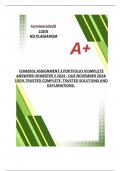, QUESTION 1 COMPANY PROFILE [5] 1 Write a brief background on the
company you have chosen to observe. (5)
To help you with writing the background on the company, could you share which specific
company you've chosen to observe? If you need a general format for structuring the company
profile, here's a template you can follow:
1. Company Overview: Briefly describe the company's industry, its core products or
services, and its mission or vision.
2. History: Provide a short summary of the company's founding, significant milestones, and
growth trajectory.
3. Ownership and Structure: Mention the type of business (e.g., public, private, family-
owned), including any relevant details about its leadership or organizational structure.
4. Market Presence: Highlight the company's presence in the market (e.g., local, national,
international), its target audience, and any notable partnerships or subsidiaries.
5. Current Position: Summarize where the company stands today in terms of market share,
reputation, and strategic focus for future growth.
QUESTION 2 COMMUNICATION IN THE ORGANISATION [20] 2.1 Briefly
discuss the difference between formal and informal networks. (4) 2.2 Identify
the formal and informal channels of communication within your chosen
organisation. Also indicate if you think these communication channels are
appropriate for the specific organisation. (6) 2.3 Describe the flow of
communication within organisations in general, with specific reference to
upward, downward and horizontal flow of communication within organisations.
(6) 2.4 How would you describe the flow of communication in the organisation
you visited? Illustrate your answer by drawing an organogram of the flow of
communication within the organisation. (Use networks or channels of
communication as guidelines.) (4)
2.1 Difference Between Formal and Informal Networks (4)
Formal Networks:
These are official communication channels established by an organization. They follow a
structured hierarchy and are typically documented in policies or procedures. Examples include
emails from managers to subordinates, official memos, company meetings, and reports. The key
aspect of formal networks is that they flow through predefined pathways, ensuring accountability
and accuracy in communication.




